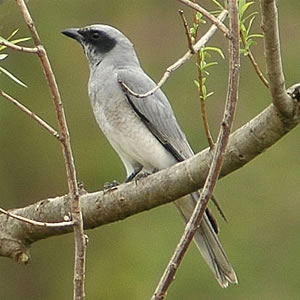
The cuckooshrikes and allies in the family Campephagidae are small to medium-sized passerine bird species found in the subtropical and tropical Africa, Asia and Australasia. The 93 species are divided into 11 genera. The woodshrikes (Tephrodornis) were often considered to be in this family but are now placed in their own family, Vangidae, along with the philentomas and the flycatcher-shrikes. Another genus, Chlamydochaera, which has one species, the black-breasted fruithunter, was often placed in this family but has now been shown to be a thrush (Turdidae).

The black-faced cuckooshrike is a common omnivorous passerine bird native to Australia and southern New Guinea. It has a protected status in Australia, under the National Parks and Wildlife Act, 1974.

The large cuckooshrike is a species of cuckooshrike found in the Indian Subcontinent and depending on the taxonomic treatment used, Southeast Asia. The species has had a long and varied taxonomic treatment, being closely related to forms across Southeast Asia, with some authors using the name Indian cuckooshrike. The species and subspecies classifications vary widely across sources and are yet to be resolved unambiguously.
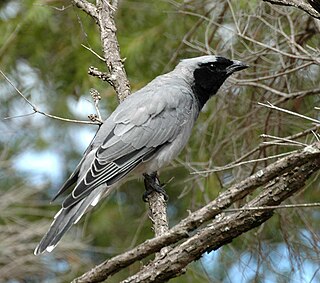
Coracina is a large genus of birds in the cuckooshrike family Campephagidae.

The blue cuckooshrike is a species of bird in the Cuckooshrike family, Campephagidae. It is found from Sierra Leone and Liberia to eastern and south-western Democratic Republic of Congo. Its natural habitats are subtropical or tropical dry forests and subtropical or tropical moist lowland forests.
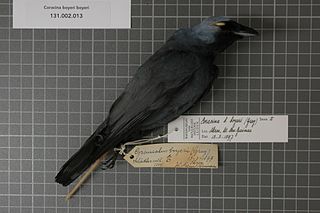
Boyer's cuckooshrike is a species of bird in the family Campephagidae. It is widely spread across New Guinea. Its natural habitats are subtropical or tropical moist lowland forests and subtropical or tropical mangrove forests.

The grey cuckooshrike is a species of bird in the cuckooshrike family Campephagidae. It is a medium-sized forest bird, with grey to blue-grey plumage and large black eyes. There are two subspecies that occur in forest patches of southern and central Africa respectively.
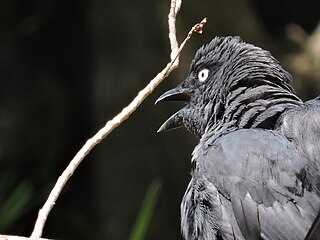
The south Melanesian cuckooshrike is an uncommon species of bird in the cuckooshrike family. It is found in New Caledonia, Bougainville Island, the Solomon Islands, and Vanuatu. The species is a large (32–37 cm) cuckoo-shrike with a long square tail and all over dark grey plumage. The eye of adults is yellow, whereas that of the juvenile is dark. Its natural habitats are subtropical or tropical moist lowland forests and subtropical or tropical moist montane forests.

The Javan cuckooshrike is a species of bird in the family Campephagidae. It is endemic to the island of Java in Indonesia. Its natural habitat is subtropical or tropical moist lowland forest.

The white-rumped cuckooshrike is a species of bird in the family Campephagidae. It is endemic to Sulawesi, Indonesia.

McGregor's cuckooshrike or the sharp-tailed cuckooshrike, is a species of bird in the family Campephagidae. It is endemic to Mindanao island (Philippines).

The white-bellied cuckooshrike is a species of bird in the family Campephagidae. It is found in Australia, the Moluccas, New Guinea and the Solomon Islands.

The Wallacean cuckooshrike is a species of bird in the family Campephagidae. It is found in the Lesser Sunda Islands and the Kai Islands. It is endemic to Indonesia.
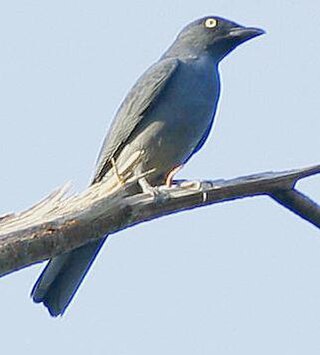
The bar-bellied cuckooshrike is a species of bird in the family Campephagidae. It is found in Thailand, Malaysia, Indonesia, and the Philippines, and its natural habitats include mangrove forest, dry forest, swamp forest, and secondary forest. The plumage varies among the subspecies, with different amounts of barring on the underparts. The International Union for Conservation of Nature (IUCN) has assessed the species as one of least-concern.

The cerulean cuckooshrike is a species of bird in the family Campephagidae. It is endemic to the island of Sulawesi in Indonesia. Its natural habitats are subtropical or tropical moist lowland forest and subtropical or tropical moist montane forest. Other common names for this bird include the Sulawesi cuckooshrike, the Celebes cuckooshrike and Temminck's cuckooshrike.

The Andaman cuckooshrike is a species of bird in the family Campephagidae. It is endemic to the Andaman Islands. It was formerly considered a subspecies of the bar-bellied cuckooshrike.
The north Melanesian cuckooshrike is a species of bird in the cuckooshrike family. It is endemic to the Solomon Islands archipelago. It is considered by some ornithologists to be a subspecies of Coracina caledonica. Its natural habitats are subtropical or tropical moist lowland forests and subtropical or tropical moist montane forests.

Edolisoma is a genus of birds in the cuckooshrike family Campephagidae that are native to the Central Indo-Pacific region, Australia and New Guinea.

Ceblepyris is a genus of African passerine birds in the cuckooshrike family Campephagidae.



















